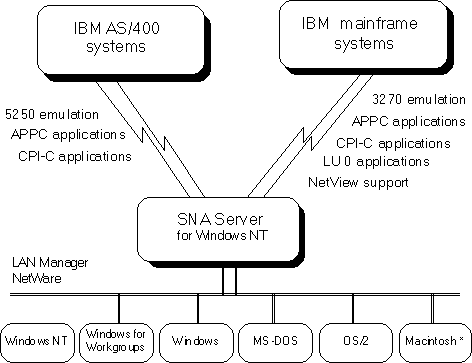
Microsoft Corporation
Created: February 2, 1993
This article explains how Microsoft® SNA Server for Windows NT® combines client-server architecture with the power and productivity of Windows® to deliver advanced connectivity between LAN workgroups and SNA networks.
Microsoft SNA Server for Windows NT makes enterprise-wide connectivity easy and economical. SNA Server offers PC users reliable and secure access to IBM host-computing with the familiar user interface of desktop PCs and the flexibility of modern LAN systems.
By employing advanced client-server architecture to distribute the communications processing, SNA Server maximizes the power of your host computers and desktop PCs. Each PC uses the LAN to connect to one or more servers using standard LAN protocols. The servers then provide shared links to host computers using SNA protocols and carry the heaviest workload, thus reducing the storage and processing requirements on desktop PCs. SNA Server offers advanced tools for easy system setup and use, regardless of the client PC operating system, LAN operating system, host connection, or host type.
SNA Server makes access to corporate and government data immersed within today's IBM SNA networks easier than ever before.

SNA Server provides flexible SNA connectivity between LANs and IBM host computers. SNA Server can support multiple concurrent SDLC, X.25 (QLLC), DFT, and 802.2 connections between the server and IBM host systems.
*Macintosh is supported as a “downstream physical unit” through the SNA Server.
| 3270 | Family of IBM mainframe terminals |
| 3270 EIS | The SNA Server 3270 Emulator Interface Specification |
| 3x74 | Family of IBM cluster controllers |
| 37xx | Family of IBM front-end processors |
| 5250 | Family of IBM AS/400® terminals |
| 802.2 | IEEE standard data link protocol |
| API | Application Programming Interface |
| APPC | Advanced Program-to-Program Communications |
| AS/400 | Family of IBM minicomputers |
| C2 | U.S. government security standard |
| CPI-C | Common Programming Interface for Communications |
| CSV | Common Service Verbs |
| DFT | Distributed Function Terminal |
| DSPU | Downstream Physical Unit |
| EHLLAPI | Emulator High-Level Language API |
| ES/9000™ | Family of IBM mainframe computers |
| IPX/SPX | Novell’s proprietary LAN protocol |
| ISV | Independent Software Vendor |
| LEN | Low Entry Networking |
| LU 0 | Logical Unit protocol often used in banking environments |
| LU 1 | Old-style 3270 printer protocol |
| LU 2 | 3270 display terminal protocol |
| LU 3 | 3270 printer protocol |
| LU 6.2 | SNA protocol for peer-to-peer communications |
| LUA | Conventional LU application API |
| MCA | IBM’s Micro Channel® bus architecture |
| NDIS | Microsoft’s Network Device Interface Specification |
| NetBEUI | Standard LAN protocol used by IBM and Microsoft in networking products |
| NetView® | IBM’s network management architecture |
| PC/AT® | Industry-standard bus architecture |
| PU 2.0 | SNA node protocol |
| PU 2.1 | Improved SNA node protocol |
| QLLC | Qualified Logical Link Control |
| RTM | Response-Time Monitor |
| RUI | LUA Request Unit Interface |
| SAA | IBM’s System Application Architecture |
| SDLC | Synchronous Data Link Control |
| SLI | LUA Session Level Interface |
| SMP | Symmetric Multiprocessing |
| SNA | IBM’s Systems Network Architecture |
| SNADIS | SNA Server’s SNA Device Interface Specification |
| TCP/IP | De facto standard LAN protocol |
| WOSA | Windows™ Open Services Architecture |
| X.25 | OSI standard packet switched protocol |
SNA Server provides flexible SNA host connectivity for LAN-connected PCs. For example, an executive of a major U.S. company can work on an important proposal from her hotel room in Boston using sales data from the Finance SQL Server in New York, and production capacities from the Manufacturing AS/400 in Dallas, then process the profit-margin analysis in the Corporate ES/9000 also in Dallas. She can then pull the results to her notebook running Windows and be ready to close the deal next day. She knows that the functionality and the operating environment are exactly the same whether in the office or on the road. The fact that the physical connection goes through Remote Access Service over TCP/IP LAN and WAN, and across a Token-Ring LAN to the IBM host systems does not concern her. The system is fully transparent—to her it is just a click of an icon: “Information at your fingertips”.
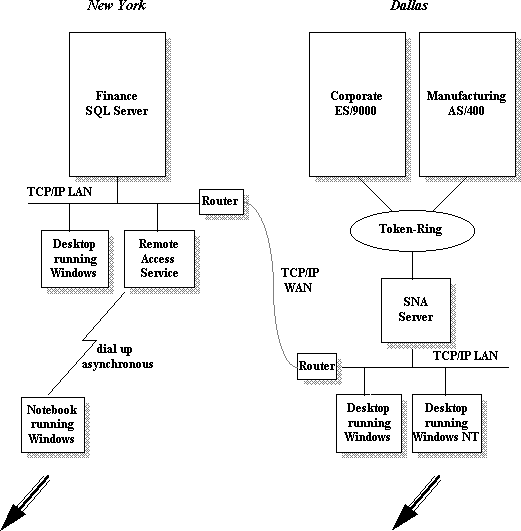
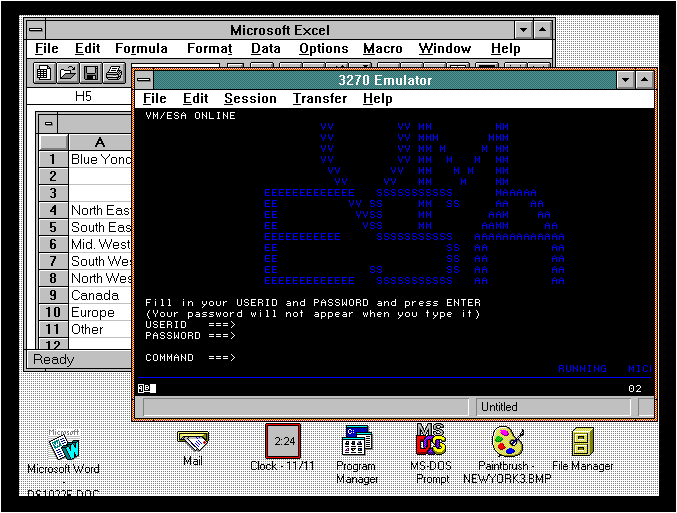
3270 display emulation provides PCs running Windows with convenient access to your mission-critical host applications.
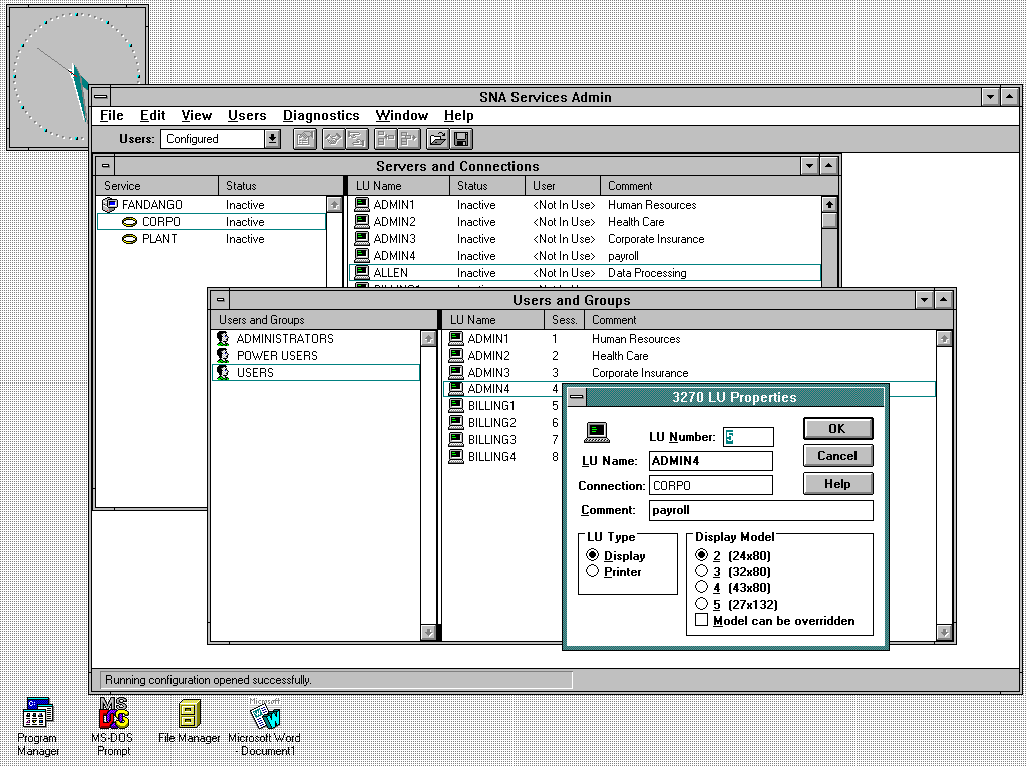
Network administrators can monitor the status of multiple servers using the SNA Server’s administration tool, or even “zoom in” on selected connections to view active users, such as those using a Token-Ring connection to the host.
Applications can take advantage of the EHLLAPI functionality provided by third-party 3270 or 5250 emulators that are supported by SNA Server’s 3270 EIS, or APPC APIs. Advanced LU 6.2 applications can use either CPI-C APIs or APPC APIs. LUA applications can use either LUA/RUI or LUA/SLI APIs. Diagnostic programs can use CSV APIs for API tracing and for NetView connectivity. The open SNA adapter support is provided through the SNADIS interface.
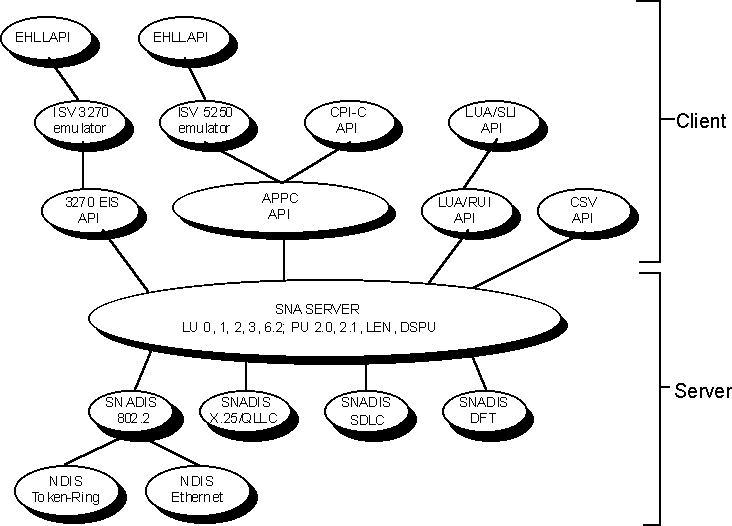
No matter how your corporate computing environment is set up or what combination of minicomputers, mainframes, and PCs you use, you need a flexible platform that meets your strategic business requirements and makes the most efficient use of your existing resources. Microsoft client-server computing gives you that advantage today, laying a solid foundation for future growth and expansion.
The right information. No matter where your corporate data resides, Microsoft client-server computing solutions help you make it a standard and easily accessible part of your enterprise-wide network, preserving and enhancing your existing investments.
To the right people. Corporate information can be used to gain a competitive advantage only if you can provide easy access to the people who need it. Microsoft client-server computing helps you give people the information they need while maintaining the control you need.
The right way. If users are to make the best use of the wide variety of resources at their disposal, they must have tools on the desktop that hide much of the complexity involved in using them. Client-server computing from Microsoft is tightly integrated with the Windows environment to provide users with the most intuitive way of working with network resources.
Right now. Advanced client-server solutions from Microsoft are available today along with the service, support, and training you need to make client-server computing an integral part of your total computing environment now and for years to come.
The Microsoft Windows NT operating system provides a reliable platform for powerful desktop and server applications.
Microsoft SQL Server controls mission-critical data while allowing authorized PC users safe access to the database.
Microsoft Mail improves enterprise-wide communications through the rapid and sophisticated sharing of electronic messages.
Microsoft System Management tracks the system’s hardware and software inventory, performs software distribution and installation, and allows central application management of both desktops and servers.
Microsoft Services for Macintosh makes it easy for Macintosh and PC users to share files, printers, and applications.
Microsoft Remote Access Service enables PC users to have access to the corporate network while away from the office.
Microsoft SNA Server provides flexible and reliable connectivity between Microsoft client-server products and IBM host systems.
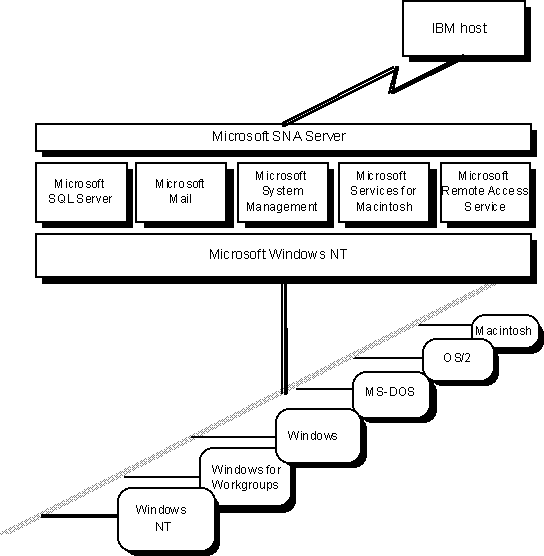
Microsoft client-server products on the Windows NT platform are compatible with the OS/2 versions of the same products, allowing easy migration and coexistence on the same network.
Server running Windows NT:
Client running Windows NT:
Client running Windows for Workgroups:
Client running Windows:
Client running MS-DOS:
OS/2 client:
Macintosh client:
The following companies have endorsed SNA Server WOSA-compliant APIs:
Andrew Corporation, Attachmate, Computer Logics, Data Connection Ltd., DCA, Easel, Eicon Technology, FutureSoft, IBM, ICOT, ICL, Microsoft, MultiSoft, NCR, Novell, NSA, Olivetti, Siemens-Nixdorf, Systems Strategies, and Wall Data.
SNADIS driver support is provided for the following adapters in the standard package; support for additional adapters is provided by the adapter manufacturer.
| Adapter | Connection | Bus Type |
| IBM 3278/9 Emulation Adapter | DFT | PC/AT |
| IBM 3278/9 Adv. Emul. Adapter | DFT | PC/AT |
| IBM MPCA | SDLC/X.25 | PC/AT |
| IBM SDLC Adapter | SDLC/X.25 | PC/AT |
| IBM 3270 Connection Model A | DFT | MCA |
| IBM 3270 Connection Model B | DFT | MCA |
| IBM MPA/A | SDLC/X.25 | MCA |
| Any Token-Ring or Ethernet adapter supported by Windows NT | 802.2 | any type |
SNA Server comes with comprehensive, context-sensitive online Help facilities and a full set of user, administrator, and developer documentation, which provides details about setting up, using, administering, and developing applications for SNA Server.